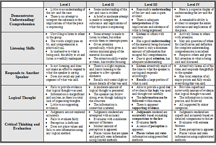Students and Teachers Alike Can Benefit from Rubrics
Joyce Kasman Valenza from The Philadelphia Inquirer Interviews Dr. Andi Stix

Did you ever wonder why your school paper got an 85 when Suzie’s got a 94? Did you ever ask your teacher exactly why? Was the answer a little vague? And did that grading process really help you understand how you might improve your work next time around? and benefit from rubrics?
Five years ago, if you had asked me what a rubric was, I would have been puzzled. Now it seems I talk about rubrics all day long.
What is a rubric? Rubrics are scoring tools built on graduated scales for each of the various, measurable subtasks or behaviors that really count in a student project. Rubrics unravel the mysteries of grading by laying out the specific criteria clearly and objectively.
In a multimedia project, for example, students may be assessed on their use of media to convey a message, as well as grammar and spelling, thesis, evidence, conclusion, and the depth of research.
Teachers benefit from rubrics by moving away from subjective grading by allowing them and others, including students themselves, to assess work based on consistent, often agreed upon, and objective criteria.
“Rubrics improve communication between teachers and students,” said Andi Stix, an educational consultant whose book A Rubrics Bank for Teachers will be published by Teacher Created Materials. Stix noted that rubrics help students understand exactly “what is expected of them when they are writing a paper or designing a project. When the criteria are laid out and negotiated, students perform at a higher level.”
In the past, when the comments on a paper said, “good job,” the student had to wonder: “Good job of what? What exactly does that mean? Why did I get a 94?”
Stix advises that when designing rubrics, the communication should flow both ways. “Once the project has been explained in great detail, it is essential that the teacher turns the focus off himself and on the students,” said Stix. “Ask the students: ‘What elements do you think I will be looking for to give you a grade?’ One student might say, ‘Organization,’ another might say, ‘We did a good job on our research,’ And another might say, ‘Well, this is a persuasive essay. Did we use good persuasive language, did it grab and hold the class’ interests?’”
This process is called negotiable contracting. After the negotiation, Stix said, “the teacher examines the negotiated criteria and may say, ‘Well, we’ve generated eight points. Let’s circle and use our favorite four or five. I like all these points, but there is one more point that I want to add as a teacher.”
Stix notes that the process of bringing out the “essential criteria” results in students and teachers having “joint ownership” of assessment.
“Clear expectations have been discussed, allowing students to perform at a higher level,” Stix said…
Teachers need good samples to guide them in developing rubrics for their classes, and the Web is a rubric gold mine… Though the experts are generally against using prefabricated rubrics for tasks, examining Web models can be a great help in seeing how other teachers and school districts have broken down criteria for various types of student projects. Of course, these models should be adapted to the needs of students. These Web sites offer a variety of approaches, from the rubric banks of large school districts such as Chicago or Fairfax County (VA) Public Schools to rubrics for teacher self-assessment, to checklists that students can use independently when writing essays. And yes, there are even rubrics for assessing rubrics.
Selections from an Interview with Dr. Andi Stix by Joyce Kasman Valenza
© 2000 by Joyce Kasman Valenza, The Philadelphia Inquirer, January 13, 2000
In what ways has rubrics help your students clarify the task at hand? Explain in detail what you have learned that has made negotiable contracting of rubrics and its criteria easy to implement? Describe specifically when it is appropriate to use or not use criteria for assessment?
Andi Stix is an educational consultant & coach who specializes in differentiation, interactive learning, writing across the curriculum, classroom coaching, and gifted education. For further information on her specialties or social media, please email her on the Contact page.






